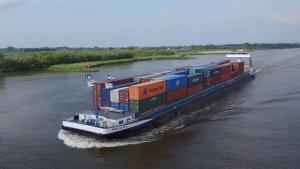Jan Drenth is the operator of two inland vessels: the Mejana and the Marajo. “We are taking part in the CLINSH project with the Mejana. First and foremost, with the aim of becoming greener, but I also believe it is important to learn more about the impact of various measures. Everyone keeps telling us what to do, but if you then ask what difference it will make in terms of emissions, how much it will help us personally, and how much cleaner it will actually be, then no one has any real answer. This is what we are now measuring as part of the CLINSH project.”
Benchmarking is important
In the CLINSH project, various entrepreneurs are investing in a range of different technologies with a view to comparing them and obtaining a realistic picture of the impact of certain measures. “We invested in an aftertreatment system with catalytic converters and soot filters. If the stories are true, then NOX emissions will be reduced by no less than 80% and soot emissions will apparently be reduced by 95%. Measurements are now being carried out to see whether these figures are correct.”
The technology and measuring instruments have already been installed on the Mejana so the first measurements have already begun. “However, it is not yet possible to measure soot emissions with this equipment at the moment. A soot measurement will therefore be carried out three times over the next three years.”
What will make the CLINSH project a success? “For us, it is important to obtain the results of the measurements. Not just for the technology in which we have invested but for all the systems. I am, of course, hoping for very positive results for the catalytic converters and soot filters.”
Shaft generator
Are there any other low-threshold measures that can help make inland shipping more sustainable? Drenth believes that the inland shipping industry has come a long way in terms of the optimum streamlining of ships, nozzles, and special rudders. “Electric-powered ships is still a step too far for the type of vessel that we use. We would need too many batteries for the distances we cover. We could perhaps increase sustainability with our generators and, for example, use a shaft generator.”
A shaft generator would replace the conventional diesel generator on the main engine and is driven by the ship’s engine. The shaft generator is used to supply the ship with electrical power during the journey. Adding this electrical energy conversion makes it possible to create a stable supply of energy even though speeds may vary. This expansion makes ships more efficient and reduces power consumption thanks to optimum control of the propulsion system at various speeds. “It is an investment that can be made when you need to replace a generator. As the shaft generator is attached to the engine,” Drenth explains, “you make optimum use of the catalytic converter and soot filter.”
Government incentive
How can inland shipping entrepreneurs be encouraged to invest in these types of solutions? “That’s a tough question. The market is still quite rigid and that is mainly due to the sky-high prices. Besides the investment in the installation (300,000 euros, ed.) – a third of which was financed by the CLINSH project – we now have additional costs of 30,000 euros per year to keep everything running.”
“Personally, I would advocate taxes that stimulate these developments. At present, the costs are so high that most entrepreneurs are being cautious and waiting to see what happens. People are waiting until it becomes compulsory, but this may perhaps take another five to ten years.” In addition, the technology is continuously developing. It is therefore not always advantageous to be an 'early adopter' in Drenth's view. The longer you wait, the better the technology will be.
“I want to be honest about this. Three years ago, we made the switch on the Marajo with the help of a subsidy programme. This time, we made the switch on the Mejana with the help of the CLINSH project. Without the subsidies, I wouldn't have done it either. The banks are now showing greater flexibility, which is a positive sign, and we also get a small amount of the port fees back, but this isn’t really commensurate with the investment that we’re making. I would advocate tax benefits on green installations, as is the case with electric cars. I think people would then start making calculations to see what is best for them. Even if entrepreneurs do not necessarily earn more as a result, there would be more enthusiasm for these types of measures. We need an incentive from the government.”
Future scenario
Drenth believes that inland shipping will definitely continue to exist but it is difficult to assess whether it will become better or worse. “It’s still a long way off. Container shipping is booming at the moment. When it comes to greening, coal and oil will certainly be given a smaller role to play, but the shipping industry will continue along its course in its current form for now. Only time will tell.”

